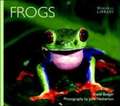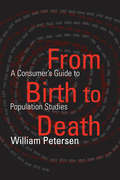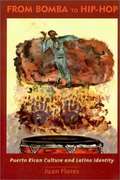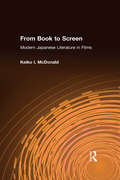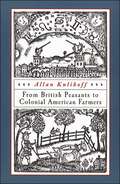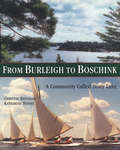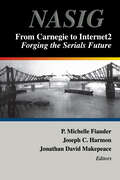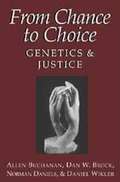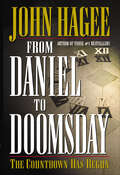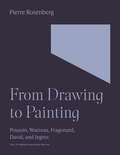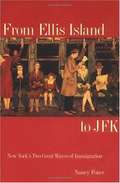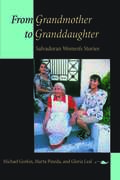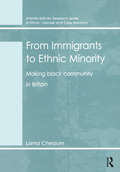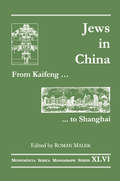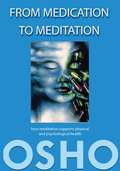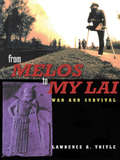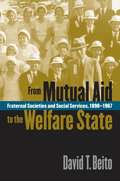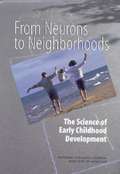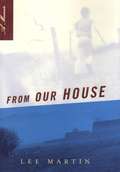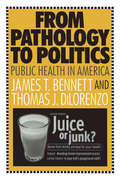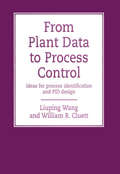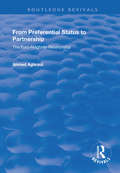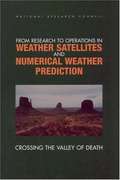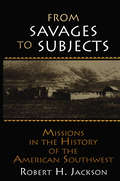- Table View
- List View
Frogs
by David BadgerFrom the Book Jacket: Frogs have long played a role in tales of legend and lore-symbolizing fertility, omens, ... and more. Frogs is an introduction to the world's most fascinating frogs and toads, including detailed frog characteristics, their life cycles, musical repertoires, and conservation issues. David Badger's interesting text and John Netherton's brilliant, up-close photographs bring these fascinating creatures to life as you've never before seen them. Discover the world's animals in the World Life Library from Voyageur Press. This highly acclaimed series brings you the latest research from leading naturalists, along with stunning color photographs of your favorite animals.
From Birth to Death: A Consumer's Guide to Population Studies
by William PetersenFrom Birth to Death is a detailed analysis of how population statistics are collected in the United States, particularly by the Bureau of the Census. It describes the errors and other flaws typically found in such data.Petersen sets out the fundamentals of demography and reviews the current proposal to use sampling in the census. He then reviews examples of how ignoring age and sex structure leads to false conclusions. Petersen explores race and ethnicity and the dilemmas inherent in the necessarily ambiguous definitions of these categories. He also analyzes the problems of women who postpone having children to ages when risks of failure become significant.The author also reviews the two most prominent population theories Malthus and the fertility transition and questions why predictions of future population size are often completely wrong. The final chapter discusses the pros and cons of state intervention in the control of fertility and efforts to cut family size in less developed countries and their unclear results. A principal topic is the relative accuracy of population statistics and the degree to which one should accept data as published. The main focus is on the United States and especially on the Bureau of the Census, but general points are sometimes illustrated with examples of how data from other countries should be evaluated.
From Bomba to Hip-Hop: Puerto Rican Culture and Latino Identity (Popular Cultures, Everyday Lives)
by Juan FloresJuan Flores considers the uniqueness of Puerto Rican culture and identity in relation to that of other Latino groups in the United States--as well as to other minority groups, especially African Americans. Architecture and urban space, literary traditions, musical styles, and cultural movements provide some of the sites and moments of a cultural world defined by the interplay of continuity and transformation, heritage and innovation, roots and fusion. Exploring this wide range of cultural expression--both in the diaspora and in Puerto Rico--Flores highlights the rich complexities and fertile contradictions of Latino identity.
From Book to Screen: Modern Japanese Literature in Films
by Keiko I. McDonaldOf all the world s cinemas, Japan's is perhaps unique in its closeness to the nation's literature, past and contemporary. The Western world became aware of this when Akira Kurosawa's Rashomon was awarded the Grand Prize at the Venice film festival in 1951 and the Oscar for best foreign film in 1952. More recent examples include Shohei Imamura's Eel, which won the Palm d'Or (Best Picture) at Cannes in 1997.From Book to Screen breaks new ground by exploring important connections between Japan's modern literary tradition and its national cinema. The first part offers an historical and cultural overview of the working relationship that developed between pure literature and film. It deals with three important periods in which filmmakers relied most heavily on literary works for enriching and developing cinematic art. The second part provides detailed analyses of a dozen literary works and their screen adoptions.
From British Peasants to Colonial American Farmers
by Allan KulikoffWith this book, Allan Kulikoff offers a sweeping new interpretation of the origins and development of the small farm economy in Britain's mainland American colonies. Examining the lives of farmers and their families, he tells the story of immigration to the colonies, traces patterns of settlement, analyzes the growth of markets, and assesses the impact of the Revolution on small farm society.Beginning with the dispossession of the peasantry in early modern England, Kulikoff follows the immigrants across the Atlantic to explore how they reacted to a hostile new environment and its Indian inhabitants. He discusses how colonists secured land, built farms, and bequeathed those farms to their children. Emphasizing commodity markets in early America, Kulikoff shows that without British demand for the colonists' crops, settlement could not have begun at all. Most important, he explores the destruction caused during the American Revolution, showing how the war thrust farmers into subsistence production and how they only gradually regained their prewar prosperity.
From Burleigh to Boschink: A Community Called Stony Lake
by Christie Bentham Katharine HookeFrom Burleigh to Boschink: A Community Called Stony Lake covers over a hundred years of human history, encompassing the Aboriginal Peoples, their presence and influence, early settlement and cottaging activity up to the present time. Family stories, local lore, boats and steamers, recreational opportunities, personalities and environmental concerns are all presented through the writings, the voices and the memories of those who were there and, in some cases, still are. Richly supported by rare photographs and other visuals of Stony Lake, this publication will bring delight to many.
From Carnegie to Internet2: Forging the Serial's Future
by P. Michelle Flander Joseph C. Harmon Jonathan David MakepeaceCouldn't attend the conference? Pick up the book!The Internet has been called a revolution, and it is; both in the ways that people and institutions communicate with each other, and in the ways that resources can now be shared. Professionals in the information field share a mandate to enable current and future generations to make use of this technology.From Carnegie to Internet2: Forging the Serial's Future is derived from proceedings of NASIG's 14th Annual Conference, held in June 1999 in Pittsburgh, Pennsylvania. This comprehensive guide to the conference proceedings discusses the powerful impact that the current explosion of information technology has had on librarianship and shares information to help you understand and benefit from these new tools.From Carnegie to Internet2 begins with a discussion of metadata--how it is created, how it is used and misused, and how to access it through search engines, including current and future access to electronic serials. Next, you'll encounter a proactive process for looking at what's to come for your library in “Scenario Building: Creating Your Library's Future.”As you proceed through From Carnegie to Internet2 you will find fascinating discussions of: full-text databases electronic serials reliable and unreliable Web sources the history of librarianship scholarly publishing by librarians the evolution of distance education . . . and much more! The current information and practical insight in From Carnegie to Internet2 will help you improve your technical skills and prepare you and your library for the 21st century!
From Chance to Choice: Genetics and Justice
by Allen Buchanan Norman Daniels Daniel Wikler Dan BrockWritten by four internationally renowned bioethicists, From Chance to Choice is the first systematic treatment of the fundamental ethical issues underlying the application of genetic technologies to human beings. Probing the implications of the remarkable advances in genetics, the authors ask how should these affect our understanding of distributive justice, equality of opportunity, the rights and obligations as parents, the meaning of disability, and the role of the concept of human nature in ethical theory and practice. The book offers a historical context to contemporary debate over the use of these technologies by examining the eugenics movement of the late 19th and early 20th centuries. In addition, appendices explain the nature of genetic causation, gene-environment interaction, and expose widespread misconceptions of genetic determinism, as well as outlining the nature of the ethical analysis used in the book. The questions raised in this book will be of interest to any reflective reader concerned about science and society and the rapid development of biotechnology, as well as to professionals in such areas as philosophy, bioethics, medical ethics, health management, law, and political science.
From Daniel to Doomsday: The Countdown Has Begun
by John HageeJohn Hagee says, "The world as we know it will end, neither with a bang nor a whimper, but in stages clearly set forth in God's Word." His latest and most provocative book takes a cue from a cultural icon, the ticking clock. Hagee presents a prophetic "Doomsday Clock" and counts down the minutes-through prophetic events-which must occur before that fateful moment when every unredeemed individual must face God on Judgment Day. Citing examples from national and international media and using Scripture to confirm his insights, he presents a compelling argument to prove that time is indeed running out.
From Drawing to Painting: Poussin, Watteau, Fragonard, David, and Ingres (The A. W. Mellon Lectures in the Fine Arts #47)
by Pierre RosenbergUnique perspectives from an acclaimed art historian on the relationship between drawing and paintingFrom Drawing to Painting interweaves biographical information about five renowned French artists—Nicolas Poussin, Antoine Watteau, Jean-Honoré Fragonard, Jacques-Louis David, and Jean-Auguste-Dominique Ingres—with a fascinating look at dozens of their drawings and the links that they have to their paintings. This book explores drawing as a site of reflection, the space between the idea of a painted image and its realization on canvas.How, why, and for whom did these artists draw? What value did they place on their drawings? How did their drawings get handed down to us? In what way do they enable us better to understand the artists’ intentions, their creative processes, and to penetrate their worlds? Pierre Rosenberg determines that each artist approached drawing in a distinctive way, reflecting his individual training, work habits, and personal ambitions. For example, Poussin viewed his drawings simply as working documents, Watteau preferred his drawings to his paintings, and Fragonard made a lucrative business selling his graphic work. For David and Ingres, drawing had a considerable pedagogical function, whether in copying the great works of their predecessors or in sharpening their own techniques.From Drawing to Painting Offers an unprecedented view of the artistic process, and makes an important and beautiful addition to any art library.Please note: All images in this ebook are presented in black and white and have been reduced in size.
From Ellis Island to JFK: New York's Two Great Waves of Immigration
by Nancy FonerTwo great waves of immigration -- one at the start of the twentieth century and another in its final decades -- transformed the history and personality of New York City. This book, the first in-depth comparison of New York's two most recent immigration eras, reassesses the myths that surround both sets of immigrants.
From Grandmother to Granddaughter
by Gloria Leal Marta Pineda Michael GorkinThe life histories and testimonies of nine Salvadoran women from different generations shape this intimate portrayal of contemporary El Salvador. The authors interviewed a grandmother, mother, and granddaughter from three Salvadoran families: La Familia Nuñez, members of the upper class; La Familia Rivas, from El Salvador's growing middle class; and La Familia García, from the campo, the Salvadoran peasantry. The voices we hear convey a deep sense of the world of Salvadoran women and how life is lived in that Central American country today. Each woman tells her own life story, and interspersed with recollections of childhood, marriage, and childrearing are revealing accounts of El Salvador's turbulent political past and present. Reflected in the stories are the vast changes in educational and occupational opportunities for women and the shifts in male-female relationships. Class differences are still a fundamental part of Salvadoran life, but changes are occurring in this area as well. From Grandmother to Granddaughter is a vivid and authentic portrait of today's El Salvador that convincingly illustrates how individual lives can reflect the larger changes within a society.
From Immigrants to Ethnic Minority: Making Black Community in Britain (Interdisciplinary Research Series in Ethnic, Gender and Class Relations)
by Lorna ChessumWhile there is an extensive sociological literature concerning race relations, racial discrimination and the process of migration, this has tended to focus on snapshots at a given moment in time. There are few historical accounts of the development of black communities in Britain. This book will be the first social history of a black community in modern times which attempts to weave many aspects of life together to give a more comprehensive understanding of the lives of black people in Britain. The book will address the way peoples’ lives are constructed through racialized identities and how African Caribbean people in Leicester relate to the wider community. It provides an important contribution to the debate concerning the social class profile of different ethnic groups. The work is gendered throughout and discusses the different nature of the experiences of men and women. The 1991 census shows Leicester to have the highest proportion of ethnic minority residents of any city outside London, however compared to other cities with black and Asian communities, it has received little attention from academics. The present study charts the development of Leicester’s African Caribbean community from its origins in the Second World War to 1981 and its changing construction from 'immigrants' to 'ethnic minority'.
From Kaifeng to Shanghai: Jews in China (Monumenta Serica Monograph Ser.)
by Roman MalekThe collection presents the proceedings of the international colloquium held in Sankt Augustin in 1997 and additional materials. The articles are written in English, German or Chinese (with English abstracts). The volume includes a general index with glossary.
From Medication to Meditation
by Osho Osho International FoundationOsho speaks in many of his talks on health as a more holistic understanding of the "BodyMindSpirit" complex. His depth of insights into what makes a healthy and whole human being plus the many meditation methods he has developed are a vital part of his overall vision and proposal to humanity. Although he never gave a series of talks specifically about health issues, he requested and titled this collection of selected material "From Medication to Meditation" which was subsequently compiled under the supervision of his personal physician.In the foreword, which is a talk by Osho given to the Medical Association in India, he paints his vision of a healthier and more whole future when he says "...every hospital will have a department of meditation. It should happen. Then we will be able to treat man as a whole. The body will be taken care of by the doctors, the mind by the psychologists, and the soul by meditation."The day the hospitals accept man as a whole, as a totality, and then treat him as such, will be a day of rejoicing for mankind." - Osho
From Melos to My Lai: A Study in Violence, Culture and Social Survival
by Lawrence A. TritleFrom Melos to My Lai presents an erudite, provocative and moving analysis of the accounts of violence in the literature and history of ancient Greece and in the film literature and veterans' accounts of the Vietnam War. This comparative investigation examines the nature of violence, its impact on society and culture, especially as reflected from th
From Mutual Aid to the Welfare State
by David T. BeitoDuring the late nineteenth and early twentieth centuries, more Americans belonged to fraternal societies than to any other kind of voluntary association, with the possible exception of churches. Despite the stereotypical image of the lodge as the exclusive domain of white men, fraternalism cut across race, class, and gender lines to include women, African Americans, and immigrants. Exploring the history and impact of fraternal societies in the United States, David Beito uncovers the vital importance they had in the social and fiscal lives of millions of American families.Much more than a means of addressing deep-seated cultural, psychological, and gender needs, fraternal societies gave Americans a way to provide themselves with social-welfare services that would otherwise have been inaccessible, Beito argues. In addition to creating vast social and mutual aid networks among the poor and in the working class, they made affordable life and health insurance available to their members and established hospitals, orphanages, and homes for the elderly. Fraternal societies continued their commitment to mutual aid even into the early years of the Great Depression, Beito says, but changing cultural attitudes and the expanding welfare state eventually propelled their decline.
From Neurons to Neighborhoods: The Science of Early Childhood Development
by Institute of Medicine Staff Jack P. Shonkoff Deborah A. Phillips Committee on Integrating the Science of Early Childhood Development Board on Children, Youth and Families StaffHow we raise young children is one of today's most highly personalized and sharply politicized issues, in part because each of us can claim some level of "expertise." The debate has intensified as discoveries about our development-in the womb and in the first months and years-have reached the popular media. How can we use our burgeoning knowledge to assure the well-being of all young children, for their own sake as well as for the sake of our nation? Drawing from new findings, this book presents important conclusions about nature-versus-nurture, the impact of being born into a working family, the effect of politics on programs for children, the costs and benefits of intervention, and other issues. The committee issues a series of challenges to decision makers regarding the quality of child care, issues of racial and ethnic diversity, the integration of children's cognitive and emotional development, and more. Authoritative yet accessible, From Neurons to Neighborhoods presents the evidence about "brain wiring" and how kids learn to speak, think, and regulate their behavior. It examines the effect of the climate-family, child care, community-within which the child grows.
From Our House: A Memoir
by Lee MartinMy father, when he was a boy, took it upon himself to change his name. My grandparents had named him Leroy Martin, but when he went to school and started learning cursive handwriting, he had trouble forming a capital ”L.” His answer to the problem was to drop the first two letters of his name and become, from then on, ”Roy.” If he couldn’t be “the King,” he would settle for merely “King.” So began his method for confronting obstacles with swift and decisive action. So begins the luminous and uniquely American memoir of Lee Martin, born into a farming family the same year his father unexpectedly lost both of his hands. Lee’s father, once known for ”doing a good turn for his neighbors,” changed that afternoon in the cornfields to become an embittered, hardened man. ”All our lives have private truths,” Martin writes, ”and the truth about my father was that after his accident he brought a deep and abiding rage into our home. I knew his hooks as intimately as I ever knew anything about my father.” Lee’s mother, called Beulah for the idyllic land at the end of John Bunyan’s The Pilgrim’s Progress, never gave up hope that salvation might one day find their home. ”How easily our bodies become us, our souls bound to the material, to the joy or grief or pain we feel through our skin,” Martin muses. Ultimately it is his mother’s quiet compassion that accounts for the grace that Lee and his father finally discover both within themselves and within their small family. Learning to live by the seasons and to fall asleep to the rumble of his father’s tractor, braving snowstorms to sell hogs or to visit an ailing grandmother, playing basketball, listening to baseball games, and stealing records, Lee endures the anger and shame that haunt his family— yet grows up to tell his tale with rare beauty and remarkable forbearance. From Our House, buoyed on every page by Martin’s deep humanity, is a wonderful book that bears all the marks of a classic. As Paul Eggers, author of Saviors, wrote: ”Every page resonates with a kind of beautiful ache, of memory rescued from anger by Martin’s compassion and yes, even wisdom. It is a heartbreakingly redemptive book, one quietly aflame with sorrow and forgiveness. Martin captures the very essence of the family romance and shows us how love—the real stuff, love that is intelligent and muscular and wide-awake— can transform even the most bitter of experiences into something approaching grace. I haven’t been this moved by a book in years.”
From Pathology to Politics: Public Health in America
by Thomas DiLorenzoBarely a day goes by without news of the latest public health threat from the American media. Some of us are told we live in a ""cancer cluster""-an area with a disproportionate number of cancer deaths. During the summer months, those who live in or near urban areas are bombarded with daily smog measurements and air pollution alerts. City water supplies are frequently called health hazards. At times, it seems as though virtually everything we eat and drink is denounced as bad for us by some ""public health expert."" Our cars burn too much gasoline; we own too many firearms; we are too fat; some of us are too skinny. Americans today are living longer than they ever have before. Why the almost daily announcements of new public health threats and proclamations of impending crises? Bennett and DiLorenzo address this question and others here. They begin by examining the large public health bureaucracy, its preoccupation with expanding governmental programs, and its concern with political issues that too often have little to do with improving public health. Then they trace the evolution of the American public health movement from its founding after the Civil War to the 1950s. They describe the transformation of public health's focus from the eradication of disease to social policy as a by-product of the 1960s. Bennett and DiLorenzo catalogue the ""radicalization"" of the public health movement by discussing its numerous political initiatives. They include case studies of the politicization of the public health movement in America. The authors reveal various methods of statistical manipulation that certain public health researchers use to ""cook the data"" in order to achieve politically correct results. A final chapter discusses the implications of the transformation of public health from pathology to politics. This vigorously argued analysis sees the public health movement as claiming expertise on virtually every social issue, from poverty to human rights. Students of public pol
From Plant Data to Process Control: Ideas for Process Identification and PID Design
by Liuping WangProcess engineering spans industrial applications in the manufacturing sector from petrochemical to polymer to mineral production. From Plant Data to Process Control covers the most up-to-date techniques and algorithms in the area of process identification (PID) and process control, two key components of process engineering, essential for optimizin
From Preferential Status to Partnership: The Euro-Maghreb Relationship
by Ahmed AghroutThis title was first published in 2000. Moving from general principles and determinants to the growing co-operation between the European Community and Maghreb states, and then onto the EU's responses to recent problems in Maghreb countries, this study concludes that a more assertive EU presence is needed, otherwise there will be damaging costs for the already fragile regional stability. The text mixes historical, political and economic analysis.
From Research To Operations In Weather Satellites And Numerical Weather Prediction: Crossing The Valley Of Death
by Board on Atmospheric Sciences ClimateThis workshop report examines the capability of the forecast system to efficiently transfer weather and climate research findings into improved operational forecast capabilities. It looks in particular at the Environmental Modeling Center of the National Weather Service and environmental observational satellite programs. Using these examples, the report identifies several shortcomings in the capability to transition from research to operations. Successful transitions from R&D to operational implementation requires (1) understanding of the importance (and risks) of the transition, (2) development and maintenance of appropriate transition plans, (3) adequate resource provision, and (4) continuous feedback (in both directions) between the R&D and operational activities.
From Revolution to War
by Patrick J. CongeDiscusses the transition from revolutionary activity to full scale war using a number of case studies.
From Savages to Subjects: Missions in the History of the American Southwest (Latin American Realities Ser.)
by Robert H. JacksonIncorporating recent findings by leading Southwest scholars as well as original research, this book takes a fresh new look at the history of Spanish missions in northern Mexico/the American Southwest during the 17th and 18th centuries. Far from a record of heroic missionaries, steadfast soldiers, and colonial administrators, it examines the experiences of the natives brought to live on the missions, and the ways in which the mission program attempted to change just about every aspect of indigenous life. Emphasizing the effect of the missions on native populations, demographic patterns, economics, and socio-cultural change, this path-breaking work fills a major gap in the history of the Southwest.
